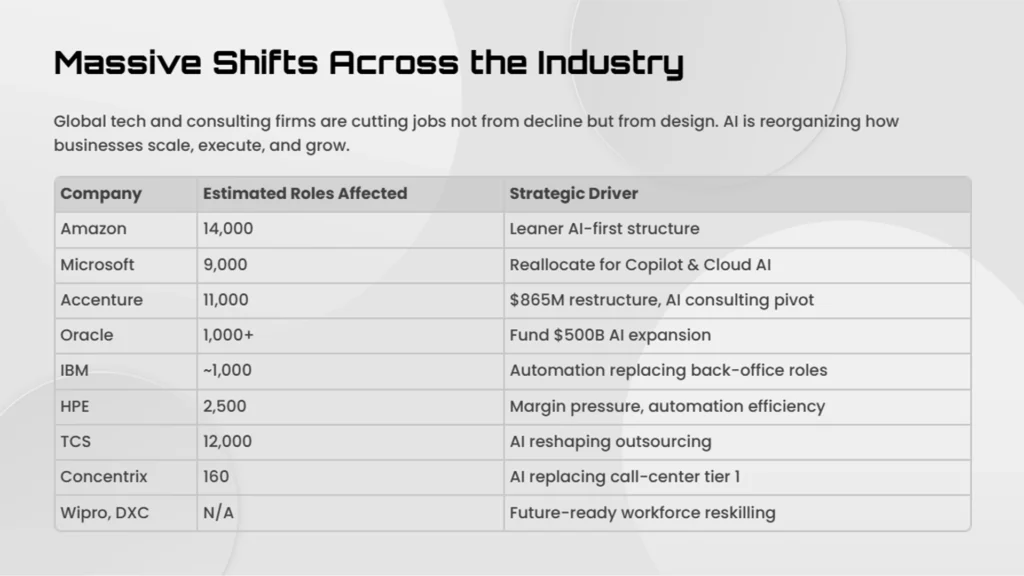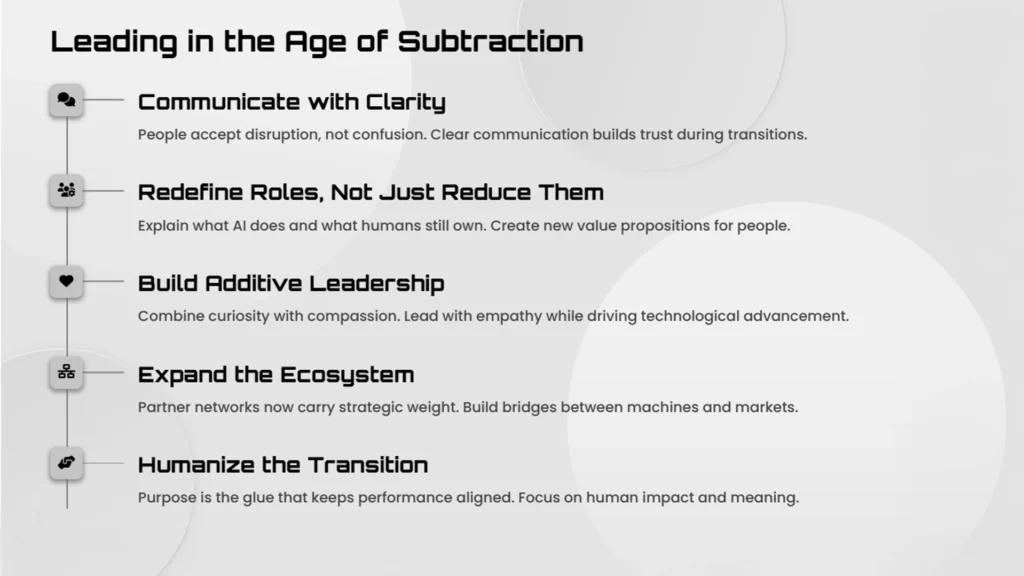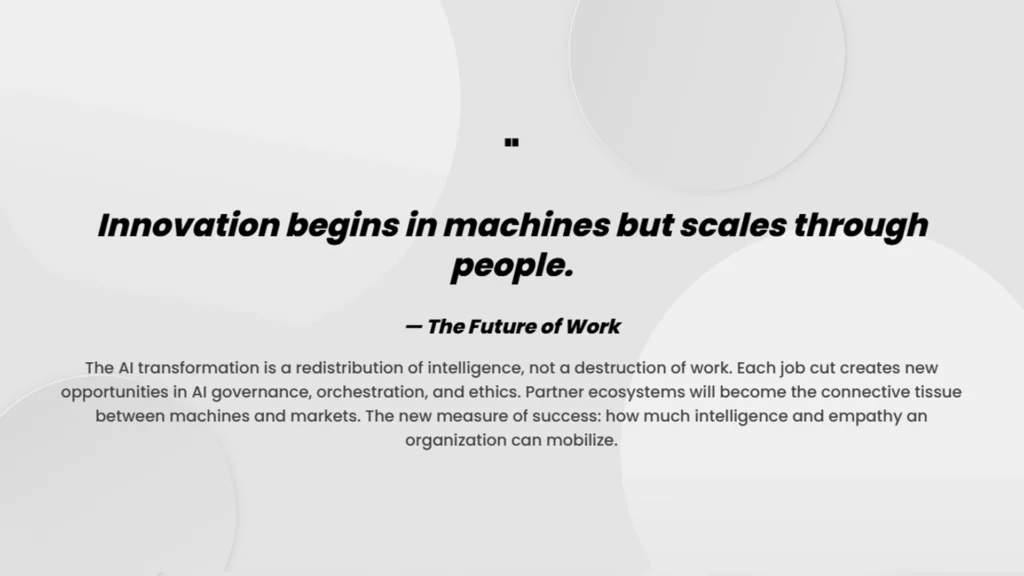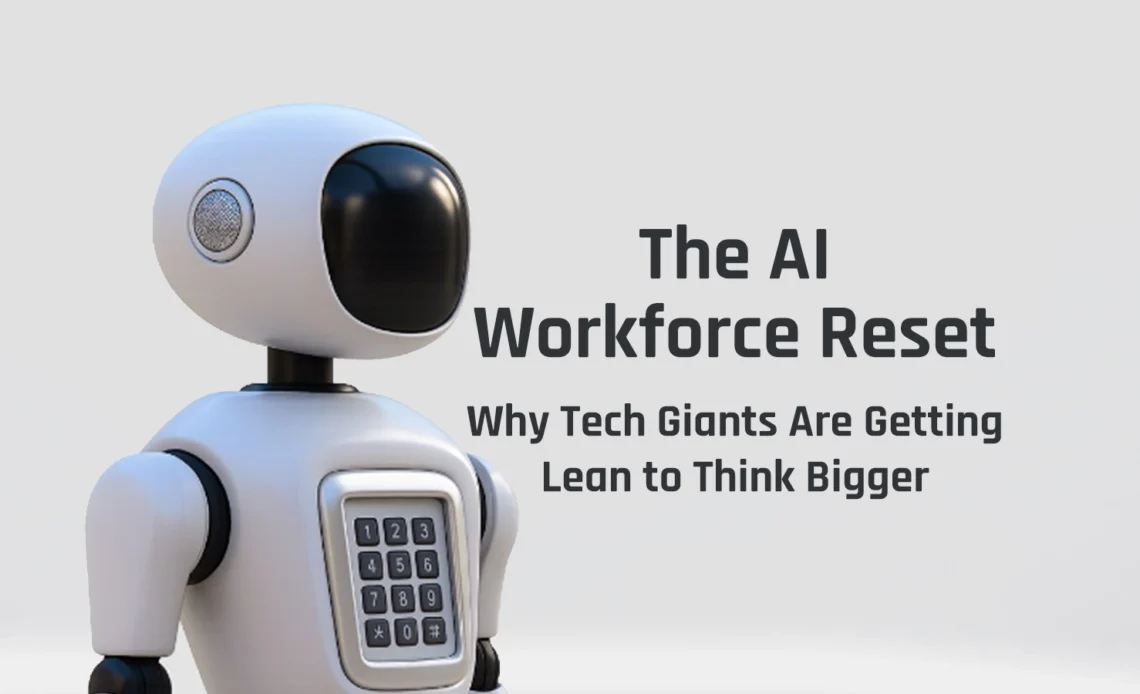There’s a paradox unfolding across the technology world.
Amazon, a company that just reported $167.7 billion in quarterly revenue, is cutting 14,000 corporate jobs. Microsoft has let go of nearly 9,000 people. Accenture, the world’s largest consulting firm, is trimming 11,000 roles while training tens of thousands in AI. Oracle, IBM, and even the outsourcing titans of India are following suit.
At first glance, it looks like another wave of corporate austerity. But look deeper and you’ll see something else taking shape: a global reorganization of work designed not to shrink ambition but to realign it around artificial intelligence.

The Great Realignment of Big Tech
Amazon’s internal memo summed it up plainly: “AI is the most transformative technology since the Internet.”
The company isn’t downsizing; it is re-architecting itself. By “organizing more leanly” and “with fewer layers,” Amazon wants to move at machine speed. Every removed layer is meant to bring decision-making closer to data and data closer to the customer.
It’s the same story elsewhere.
✅ Microsoft shed roughly 4 percent of its workforce to fund massive AI infrastructure investments and Copilot expansion.
✅ Oracle cut hundreds across its cloud infrastructure unit and India operations, redirecting billions toward AI growth.
✅ IBM quietly trimmed marketing and HR teams as it automated back-office workflows while hiring more sales and AI engineers.
✅ Even Cisco and HPE, long seen as hardware stalwarts, announced selective reductions tied to efficiency and automation.
The message is consistent: the future of scale will no longer be measured in headcount but in algorithmic capacity. These companies aren’t replacing people with machines; they are replacing complexity with clarity.

Consulting’s Inflection Point
In professional services, the disruption feels even sharper.
Accenture’s CEO, Julie Sweet, described it without euphemism: “We’re exiting people where reskilling is not a viable path.” The firm announced $865 million in restructuring costs, including severance and divestitures, while doubling its investment in data, cloud, and AI-driven consulting.
Other advisory giants are following suit.
KPMG flagged $80 million in cost cuts and 200 roles to reshape its business around AI. EXL Service is reducing 800 positions to focus on intelligent automation. McKinsey, PwC, and others are quietly flattening their pyramids with fewer junior analysts and more AI-augmented delivery teams.
It’s a profound irony. The very firms that built their reputations advising others on digital transformation are now forced to transform themselves. The pyramid model that defined consulting for decades is eroding. AI doesn’t need armies of analysts; it needs orchestrators, storytellers, and strategists who can make sense of what the machine delivers.
For partners and ecosystem leaders, this is a warning and an opportunity. The consulting firm of the future will not just analyse change; it will co-create it alongside intelligent systems.
The Outsourcing Shake-Up
Nowhere is the impact of AI more visible than in the $283 billion outsourcing and contact-centre industry, once the engine of global employment for millions.
Tata Consultancy Services (TCS) announced the layoff of more than 12,000 employees, citing “skill mismatches” as AI begins to handle coding, testing, and routine customer interactions. Wipro and DXC are restructuring toward “future-ready” operating models, reskilling where they can and exiting where they can’t.
In the United Kingdom, Concentrix, a major contact-centre provider, cut around 160 roles on a Scottish Power contract, replacing portions of the work with AI tools and near-shore automation.
The pattern is clear: labour arbitrage has become automation arbitrage. Clients no longer seek thousands of human agents answering phones; they want adaptive systems trained on context, language, and emotion. For outsourcing leaders, survival now means becoming architects of AI-enhanced workflows, not just managers of human ones.
This wave is not limited to Asia or Europe. The United States is debating bills to restrict offshoring of AI-driven contact-centre operations, forcing a rethink of business models everywhere.
The world’s largest service factories are being retooled into lean digital foundries.
Leadership in the Age of Subtraction
The challenge isn’t technological. It is human.
What does leadership look like when progress means doing more with fewer people?
How do you preserve trust, purpose, and culture when automation becomes your growth engine?
We’ve entered what I call the Age of Subtraction, where leaders gain advantage not by adding more but by removing friction, redundancy, and indecision. Yet subtraction without vision breeds fear. Leadership now demands a new muscle: turning anxiety into alignment.
In my years leading partner ecosystems across more than twenty countries, I’ve learned that transformation succeeds when people understand why they’re being asked to change. Employees can handle disruption, but not confusion. In this new era, clarity is the most compassionate form of leadership.
The companies that win will not be those that automate the fastest, but those that communicate the clearest, who can say, “Here’s what AI will do, here’s what humans will do, and here’s how both will grow together.”
The Ecosystem Opportunity
For every job lost within the tech giants, new opportunities are forming outside them.
As Amazon, Microsoft, and Accenture streamline, their ecosystems expand. Partners, integrators, and startups now become extensions of corporate intelligence.
Every internal efficiency creates an external gap, and someone must fill it. That is where the next wave of growth will happen.
We are seeing the rise of AI-managed service providers who blend data engineering, governance, and vertical specialization. We are seeing regional GSIs in EMEA and Asia emerge as orchestration hubs between hyperscalers and enterprises.In this sense, layoffs are not the end of growth; they are redistribution events.

Talent migrates from large organisations into the ecosystem, carrying know-how, customer familiarity, and entrepreneurial energy. If history is any guide, this outflow of experience will fuel the next generation of AI-native ventures.
From Job Cuts to Knowledge Shifts
What we are witnessing is not a labour crisis; it is a knowledge recalibration.
AI is reshaping the very physics of productivity. It is compressing what once required departments into digital models. It is making room for new categories of work: AI governance, synthetic-data engineering, model evaluation, agent orchestration, and human-machine ethics.
But the deeper question remains: What kind of leaders will we become?
Will we let AI make us smaller, more cautious, more transactional? Or will we use it to expand our sense of possibility, to build ecosystems that are faster, fairer, and more inclusive?
The future of work is not about the number of employees in a company. It is about the amount of intelligence, creativity, and empathy the organisation can mobilize, human and artificial, together. enablement.
Partners are no longer just resellers. They are developers in their own right. Treat them that way.
Closing Reflection
The AI workforce reset is not a tragedy of lost jobs; it is a transformation of purpose.
Across tech, consulting, and outsourcing, the winners will be those who see this moment not as contraction but as concentration, of focus, clarity, and capability.The world doesn’t need more layers. It needs more leaders who can bridge ambition with alignment and technology with humanity.
As AI rewrites how companies grow, one truth endures: innovation may start in machines, but it scales through people.


